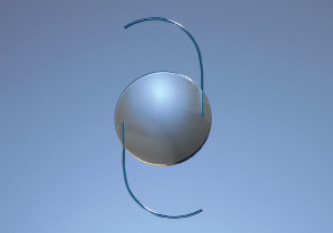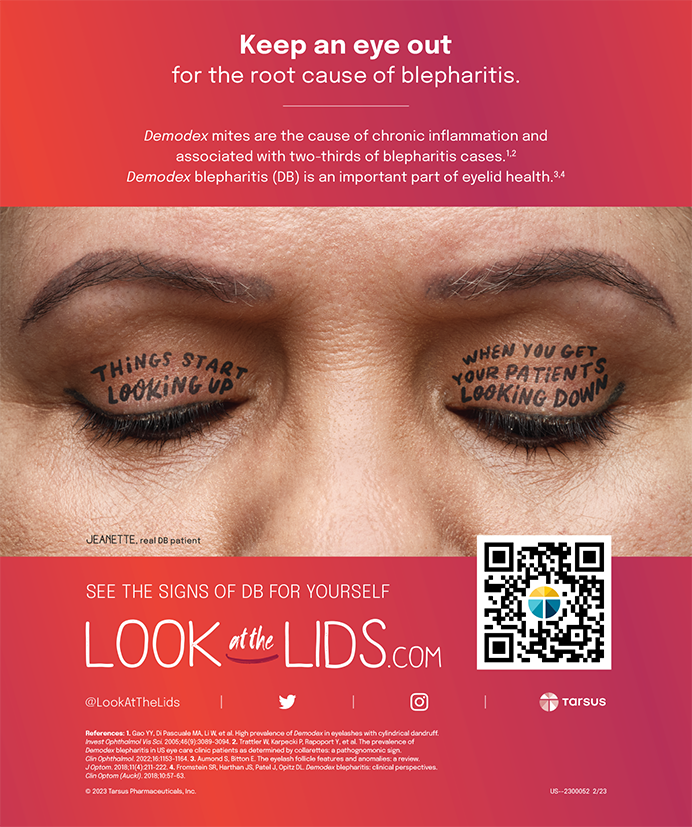
Despite advances in modern IOL designs and diagnostic technologies, cataract surgeons still have only one shot to get it right, and we remain limited by the ability to predict the postoperative status of the eye. A resulting lack of confidence in being able to satisfy demanding patients has clearly limited adoption of toric and presbyopia-correcting IOLs. LASIK far more consistently meets or exceeds patient expectations and is easily enhanced postoperatively; this increases confidence in pitching the technology.
This differential may soon change. The »RxSight Light Adjustable Lens (RxLAL; RxSight), the first IOL designed to be noninvasively adjusted after implantation (Figure), received FDA approval in November 2017. The RxLAL is a foldable three-piece IOL made of photosensitive silicone that is implanted using routine preoperative and surgical techniques. Approximately 2 to 3 weeks after implantation, the patient returns to have his or her vision and refraction evaluated. If there is residual error, the surgeon enters the desired refractive change into the Light Delivery Device (LDD; RxSight), a UV light source also approved by the FDA in November. The UV light from the LDD is used to modify the shape and focusing characteristics of the lens.

Figure. The RxLAL is designed to be noninvasively adjusted after implantation.
The light treatments take place in an office setting and last around 90 seconds; they can be performed multiple times, as needed. Once the desired vision is achieved, the custom prescription is permanently locked in. Until the refractive change is permanent, patients must wear special UV-protective glasses to prevent exposure of the IOL’s photosensitive silicone material to UV light.
In patients implanted with the RxLAL, the LDD can be used to treat postoperative manifest cylinder from -0.75 to -2.00 D and manifest sphere from -2.00 to 2.00 D.1
In the pivotal study that led to approval of the IOL and LDD, 91.8% of eyes achieved a result within ±0.50 D of target manifest refraction spherical equivalent,1 which is similar to the refractive accuracy seen in recent LASIK studies.2 This level of accuracy will clearly benefit distance vision and astigmatism and monovision refractive corrections. Postoperative adjustability may also have great utility in eyes that have undergone previous corneal refractive surgery, and future technology advances are likely to provide additional presbyopic solutions.
EASY TO USE
As one of the investigators in the 17-site US clinical trial, I implanted and adjusted a significant number of RxLALs. The presurgical and surgical experiences did not require any additional skills beyond what a cataract surgeon is familiar with. Postoperatively, the LDD was easy for me to use and comfortable and painless for patients. The protective UV glasses were not difficult for patients to use.
The lens requires extra visits and a shift in refractive counseling from pre- to postoperative. Nonetheless, my patients experienced a wow factor like I have never seen before with traditional monofocal IOLs. It is my expectation that adding postoperative adjustability to cataract refractive practices will serve to expand the premium IOL channel.
1. Light Adjustable Lens (LAL)/Light Delivery Device (LDD). Summary of Safety and Effectiveness Data. US Food and Drug Administration. November 22, 2017. https://www.accessdata.fda.gov/cdrh_docs/pdf16/P160055B.pdf. Accessed April 9, 2018.
2. Sandoval HP, Donnenfeld ED, Kohnen T, et al. Modern laser in situ keratomileusis outcomes. J Cataract Refract Surg. 2016;42(8):1224-1234.


